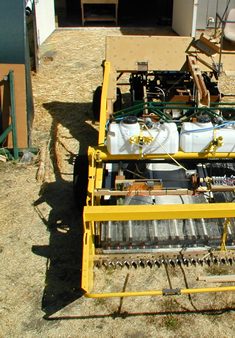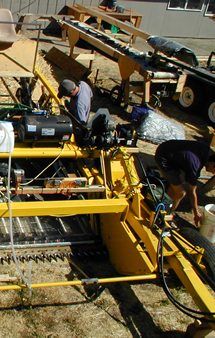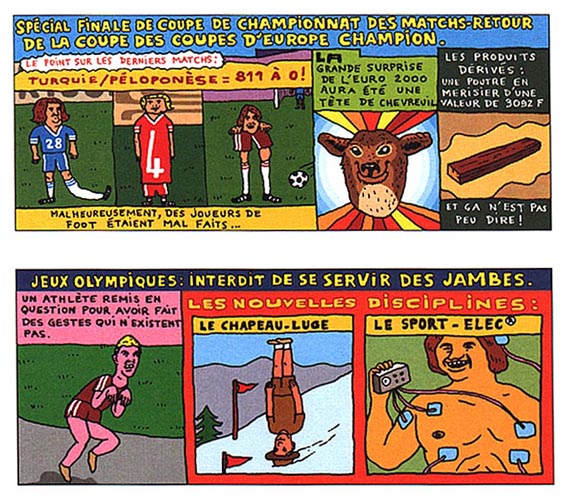My (raw) notes about the 3 projects discussed during the second blogject workshop held in Lausanne:
1) Ubicamera (Julian Bleecker, Sascha Pofhlepp, Mark Meagher, Frédéric Kaplan): Starting point: how blogjects would be used to circulate culture.
I my camera knows that I am in Amsterdam and also that I was there 6 months ago, it would link up on Flickr and establish a network of different sources.
Or, if I go to an event and takes picture, the camera will check other Flickr pictures automatically
"The Flickr camera" is driven by a fascination towards media sharing as a cultural practice. This group thought about how to turn this into the next level of interaction: the social practice of Flickr into a blogject
There are 3 primary Flickr characteristics embedded in a camera:
- the interface (fluidity)
- association: sharing pictures amongst friends and strangers
- browsing practices: go there and look at the 10 different photo of your contacts and then check pictures of a group whom your friends belongs to ("big brown things").
Scenario: Sascha walk down the road, he sees a Totem, take a picture; a public/private indicator shows up as well as the opportunity to select certain tags: certain are preloaded and other tags are there just becasue the camera has foudn them.
Social camera situation: meet other blogject camera. As you maneuver through your day, you come across similar camera and communicate: embodiment of the Flickr association to find similar pictures and people. You can also specify the tags you're interested in and the camera would download the pictures of others you meet serendipituously (these people won't even know).
Also, the camera is GPS-enabled: location can be another key to find information /people/pictures: it's then an exchange of tags based on location. The camera can also tell the others which tag is proper.
As for the browsing practice, the question is "how do we use the camera as a display device?" Not just for browsing but also navigating in a way that is as compelling as Flickr. There could be different interfaces: photo can be shifted accordingly with time/space/personality/trajectory. The photostream is then the stream of life of the owner; when 2 cameras take the same picture, there would be an intersection of 2 lives: this should also be displayed.
The camera has also a life of its own: no buttons, the photo can't be deleted. What happen if you buy such camera on a flea market? You buy a camera but also the pictures taken by the previous owner.
Timo was interested in this sort of interface as well as the tagging practices it would generate
2) Nabaztags and blogjects (Fabien Girardin, Alain Bellet, Regine Debatty, Cyril Rebetez)
Starting point: Using Violet's Nabaztag (the wifi rabbit) as an output device or a blogject aggregator. Using it as a way to make sense of history of interactions. It could also be a nice channel.
A part of the "blogjectsphere"
"Not a rabbit that helps loosing weight" but a spokespet. The main features would be:
- reminder/teaser/awareness
- trigger for actions or to drop an action you are doing based on the data collected by the blogject
- a spokesperson for voiceless objects in the form of a rabbit: it would recycle and analyze data from the environment (other objects), managing an ecosystem of data. The ecosystem of objects is made of objects which have simple sensors:
- letters with your bills you have to pay (RFID tags): a reminder that you have 5 bills to pay
- trash: the rabbit will know the status of your trash as can act as a reminder or warner ("don't put that can in the bin, it's only for paper")
- water the plant: the rabbit recives the answer of the plant sensors and reminds you that you should water it
- playful or unpleasant reminder
- the action generated by one sensore can trigger another blogject
- the rabbit can talk to your friends' rabbits and your pedometer in your shoe can activate your friends' rabbit: "hey your friend went running": awareness of others so that you might eventually choose to join.
- the collar of your dog can communicate with the rabbit: a translator of the barking dog or as a warner that you have to go out with him.
Fabio Sergio was struck by the desire of human beings to have objects that would be like us and he pointed us on the fact that it is antithetic with the fact that animal can act badly. The question is then "do we really want things to have a personality because we would need to manage them?" Do we want to have this sort of relationship with objects?
Sascha raised the question of the underlying cultural aspects: from "mute servants" to agents. But Cyril reminded us that psychology showed that we project meaning and intents anyway.
3) Mobile phones and blogjects (Timo Arnall, Fabio Cesa, Fabio Sergio, Marc Hottinger, Nicolas Nova)
Starting point: The mobile phone is a generic device (phone, take pictures, post it on Flickr...): can it be turned into a blogject? or a blogject controller?
If we become surrounded by blogjects, how do we manage that situation?
The mobile phone as a tool/wand/interface
What are the potential social issues










